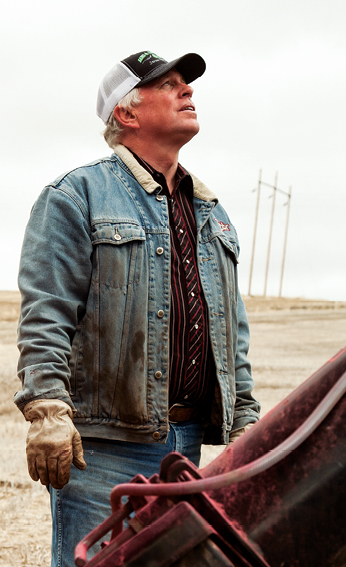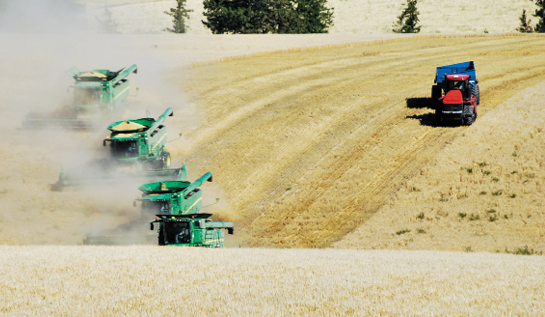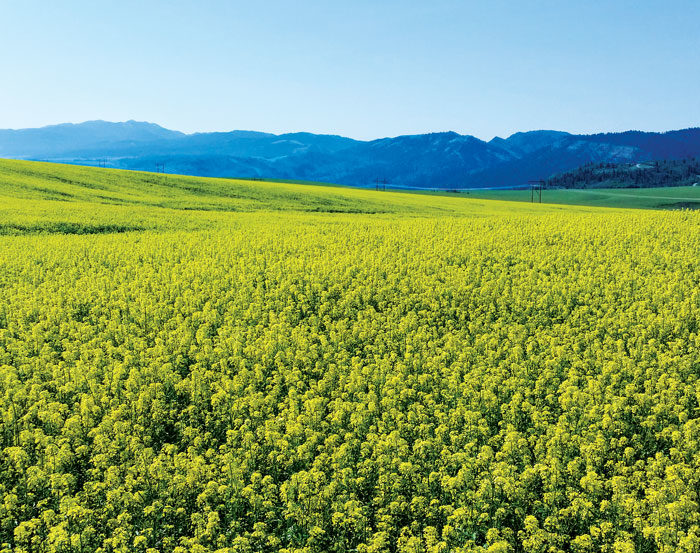Pictured Above: ROTATION WINNER. When markets finally allowed for Gordon Gallup to get mustard into his barley-wheat rotation, he found surprising benefits, such as a reduced need for nitrogen and less wireworm pressure in his subsequent crops.
Check The Specs...
NAME: Gordon Gallup
FARM: G 5 Land and Livestock
LOCATION: Ririe, Idaho
YEARS NO-TILLING: 31
NO-TILL ACRES: 5,000
CROPS: Winter wheat, spring wheat, barley, malt barley, mustard and alfalfa
Dryland with only 16 inches of annual rainfall means farming a lot of acres if you want to support a family and turn a profit in eastern Idaho. That also means farming a lot of hours — at least it did when we were farming conventionally.
We’ve left those days in the dust, literally, and with no-till we can now farm nearly five times the acres we did then and in less time.
We purchased our farm in Ririe, Idaho, from my parents in 1978. Back then, we did everything as had been done before. We raised wheat and barley in a summer fallow rotation, meaning we only got a crop every other year.
At the time a friend of mine who was a fertilizer dealer was the first person to suggest that we could probably get a crop off our fields 9 years out of 10, if we could conserve the moisture we were losing to our tillage practices. Some fields would get worked 10 times a year with fallow and planting preparation, depending on the conditions.

Gordon Gallup
His comments got us thinking and we started dabbling in continuous cropping. We also started paying a lot of attention to our neighbors up in Northern Idaho and the Palouse region of Washington who were making great strides with no-till in their regions.
Erosion Buster
In the early 1980s we were experiencing a lot of heavy downpours, which caused significant gully erosions in our hilly fields. We would have to go out and repair the gullies with moldboard plows to even be able to farm through them.
At the same time I was traveling to meetings put on by Guy Swanson, the creator of the Yielder no-till drill. After a few years, a couple of my neighbors and I decided we could probably make no-till work.
Soil conservation was an area we really wanted to improve on our farms and it seemed no-till was the answer to the problem. We reasoned if they could keep the Palouse hills from eroding, our hills should definitely benefit from the practice.
Each of us committed to buying our own Yielder drill in 1985. I ended up having to sell all my tillage equipment and my big tracked Caterpillar crawler tractor to purchase the 12-foot drill. At that point, I was fully committed to no-till with no room for second-guessing.
We had already changed our cropping system to mostly eliminate fallow. This meant we would chisel plow everything in the fall with our wheeled or Caterpillar tractor and then work the ground a couple of times in the spring with the two tractors. Between those operations we put a lot of hours on the tractors — probably 1,500 total — to farm 1,200 acres each year.
The first year we planted with our new Yielder no-till drill we planted the same acreage while racking up only 100 total hours on our wheeled tractor. That is an incredible savings in man-hours and wear and tear on our equipment.
Besides being no-till, the sheer weight of the Yielder drill forced us to change how we planted. We didn’t have the horsepower to pull the drill up and down fields, so we started seeding all of our fields with the contour of the hills. This provided an immediate benefit, as any rainfall we got didn’t have a direct path to run down the hills and take soil with it.
Early Success

SPREADING OUT. While Gordon Gallup was able to spread straw easily behind his combines in the early years, there was always a band of chaff that caused temperature variations and, therefore, problems at planting. His current John Deere 670 combines with 30-foot draper headers are better able to spread chaff and straw the width of the header.
We hit it really lucky and had some excellent years right off the bat with no-till. You hear about yield drags and transition years, but we were fortunate enough to put together about 5 years of good conditions — at least for no-tillers — and skip some of those transition headaches.
Those first years were made for showcasing the benefits of no-till. We had good springs and then the weather turned hot and dry really quickly. Right away we noticed conventional fields in the area getting hit with drought stress while ours continued to thrive. There’s an old joke that no-till fields are just the last to die, but ours did well and held on until we got our late June rains.
With less tillage and minimal soil disturbance at planting to keep a mulch layer intact, we were obviously conserving moisture that the plants were able to use to survive, thrive and produce yield.
Our yields were actually much better with no-till than when we were using conventional tillage. Besides moisture savings, we attribute a large portion of that success to more precise fertilizer placement with the Yielder drill.
In the past we would apply anhydrous ammonia prior to planting. The Yielder drill was set up so we could band our fertilizer right between the rows. The plants were able to tap into a concentrated band of fertility when they needed it instead of searching around and coming up with less. Our crops really thrived with this system.
Many guys in our area use starter fertilizer, but I’ve become a believer in just deep banding all our fertility. I’ve found in no-till that growers who use starter fertilizers have roots that set high in the soil profile, using that fertility in the seed zone. When it gets hot and dry, those plants get stressed and have to go deeper in the soil for fertilizer and moisture.
By banding fertilizer, my plants set roots lower and are already to the deeper fertilizer when stressful conditions arise.
Thirsty Soils
Over time it became obvious our soils were benefiting from our no-till practices, too. We got a particularly heavy storm just a couple years into no-tilling in 1988, and it delivered around 3 inches of rain in a 24-hour period. There was huge runoff and erosion on conventionally tilled ground.
In our no-till, contour-planted fields, the water did move down the steep hills, but it was slowed by the debris and by filtering through each row of grain. Very little water came off the field and what did was very clean. We had zero gullies come harvest, which was impressive.
Preventing erosion was great, but the huge benefit we saw with this storm was we were able to keep a large portion of that moisture in the field. That moisture was there for the plant to tap into and help finish out the grain. It’s one thing to keep winter moisture in place, it’s another thing entirely to be able to capture those summer storms and keep that water on the hills.
Observation told us our soils were soaking up the moisture, but we also got the opportunity to see some scientific proof. About 15 years into no-tilling we had a gentleman, John Kimble, come to our farm who was surveying soil types worldwide. When I was out with him, we went in a field that was continuous cropped but conventionally tilled, adjacent to my fields. As we drove across, it was very soft.
When we got to my field it was much more firm. In my mind, I relate soft to a sponge and firm to a floor, so I was thinking his field was probably going to be able to absorb more water than mine. I was wrong.
As part of the survey, we did a rain simulation to test water infiltration. In the conventional field, the soil was able to absorb just ½ inch of water per hour before we started to see runoff. In my 15-year no-till field, we got 3½ inches of water absorbed per hour before we saw an erosion effect.
Then we went to native soil that had never been farmed. We couldn’t put enough water on that soil to make it run. We made it all the way up to 15 inches before we gave up. That proved to me that undisturbed soils were best when it came to capturing rain, and my soils were definitely headed in the right direction.
Warming Up
We’ve made some changes over our years of no-tilling. One of the biggest changes is we farm a lot more ground because no-till freed up a lot of time for us. We now farm 5,000 acres.
More acres meant getting a bigger drill. We now use a 60-foot Concord air drill. We gave up some precision, but we’re learning to work with the change.
One difference is the Concord is a hoe drill, which means we have a little more soil disturbance than we did with the Yielder disc-style drill. This has actually been an advantage for us in cold springs when the soil temperature stays low. The slightly larger strip of blackened soil warms up faster, which helps get our crops up and growing a little quicker.
The drill bands fertilizer 3½ inches deep and seed is distributed 1½ inches on either side of the back of the seed boot.
We did opt to replace the factory hoes with Dutch openers. They move a lot less soil than the factory boots, which we prefer for no-till, and they require less horsepower to get them through the field.
Rotation Booster
It turns out that wheat and barley isn’t really a rotation — something the University of Idaho had been telling us for some time — so over the years we’ve made an effort to get some more crops into the mix on our fields. We’ve raised canola in the past, but mustard has been our more recent rotation crop.

CHILLY START. A Flexi-Coil Concord air drill brought Gordon Gallup more width, faster planting and just a little more soil disturbance than the disc drill. Gallup says this can be a good thing, as his crops germinate faster in cold springs in that small band of black dirt that soaks up the sun’s heat.
We farm for profit, which is part of why it took us awhile to step back from the wheat and barley rotation. There wasn’t much of a market for other crops we could grow, which is also limited by our 6,000-foot elevation and dry conditions.
However, Mountain States Oilseeds came into our region and offered contracts for mustard that were very competitive with our malt barley contracts, so all of a sudden a real rotation was an option.
Having mustard in the rotation allows us to keep any grassy weeds in check by opening up our herbicide options. It wasn’t a major problem for us, but we did have some grass creeping in from the edges of our fields with no-till. Roundup didn’t seem to be taking them out.
Wireworm has become a significant issue in our area. I’ve had wheat that was 6 inches tall and when I came back 2 weeks later two-thirds of it was gone. A lot of the chemicals we used to use on wireworm have been taken away, so they’re really making their mark. But we seem to have less wireworm damage in wheat crops following mustard in the rotation.
We have one field in particular that has been plagued by wireworm. Last year, following mustard, that field produced the best crop it’s had in 5 or more years. They say mustard and other brassicas produce a natural fumigant. I don’t know if that is what’s holding the wireworms off, but something is definitely happening there.
Another interesting thing we had come up in the last few years is a sharp drop in our nitrogen (N) needs. We soil test every year using GPS tracking to pull samples from the same spots. For decades we’ve had the recommendation to apply 70-80 N units per year for wheat production. This year the recommendation was 30-40 N units on the high end.
These numbers were especially surprising, as last year we had one of the best crops we’ve ever had. I would have expected that heavy crop to deplete the N, but that wasn’t the case.
I’m not certain why there was a sudden change, but I suspect having mustard in our rotation is the key, as it’s the only significant change we’ve made recently.
Mustard Hurdles
Mustard does bring up some no-till challenges for weed control.
There aren’t a lot of weed control options, so we apply Treflan herbicide impregnated on dry fertilizer and broadcast it on the field prior to seeding. Without the fertilizer carrier, liquid Treflan would get tied up by the stubble and mulch present with no-till. With the carrier, we usually get a little rain after application and it’s taken down past the residue to the soil where it creates a barrier.
The barrier is key, so we’ve found we have to use a disc drill to seed mustard. The hoe drill disturbed too much soil — and the Treflan barrier with it — allowing weeds to work their way in.
We use a 40-foot Case 500T no-till drill for the job. We seeded around 700 acres of mustard this year and are working to have it in a 5-year rotation on our farm.
Cover Experiments
Diversity has proven itself beneficial on our farm, so we’re now dabbling in growing peas and investigating cover crops, too. We have dry falls, so establishing cover crops can be difficult — if not impossible — but sometimes we have a fit for them in our rotation.
For instance, we were taking a field out of CRP that had been a solid stand of grass for 20 years. In our experience, those fields are deeply depleted and usually require the highest fertility rates we use on the farm.
In this case we sprayed out the CRP acres on May 1 and no-tilled a cover-crop mix with 16 or more species, including radishes, turnips, corn and hairy vetch. I went with a mix in an effort to address multiple issues including compaction, fixing N and breaking up disease and pest cycles. I basically wanted to throw a curveball at those acres where everything had been static for years.
Everything grew well in the mix and the moisture retention in the field was phenomenal. It’s opposite of what you would think. Here we’re growing a crop and somehow getting better moisture and soil tilth than acres not growing a crop. The roots just seemed to help pull moisture deeper in to the soil profile faster.
We desiccated the cover crop in mid August, came through with a light tillage pass to level the ground a bit and then seeded winter wheat. The ground was extremely mellow and the crop came up and was just beautiful. I feel like using the cover crop really helped us transition that field with a level of success we hadn’t seen with past efforts that didn’t include a cover crop.
No-till has really turned out to be the best choice for our farm. It has helped us grow, helped us get control of erosion and to just generally be more profitable and efficient. Looking back, I would have to say no-till is the only reason I’m still farming.








Post a comment
Report Abusive Comment